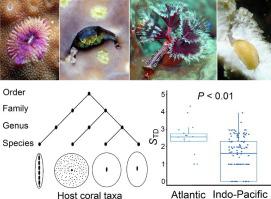International Journal for Parasitology ( IF 4 ) Pub Date : 2023-10-12 , DOI: 10.1016/j.ijpara.2023.09.002 Roeland J van der Schoot 1 , Bert W Hoeksema 1

|
Coral-associated fauna predominantly consists of invertebrates and constitutes an important component of coral reef biodiversity. The symbionts depend on their hosts for food, shelter and substrate. They may act as parasites by feeding on their hosts, by overgowing their polyps, or by excavating their skeletons. Because some of these species partly reside inside their hosts, they may be cryptic and can easily be overlooked in biodiversity surveys. Since no quantitative overview is available about these inter-specific relationships, this present study adresses variation in host ranges and specificity across four large coral-associated taxa and between the Atlantic and Indo-Pacific oceans. These taxa are: coral barnacles (Pyrgomatidae, n = 95), coral gall crabs (Cryptochiridae, n = 54), tubeworms (Serpulidae, n = 31), and date mussels (Lithophaginae, n = 23). A total of 335 host coral species was recorded. An index of host specificity (STD) was calculated per symbiont species, based on distinctness in taxonomic host range levels (species, genus, family, etc.). Mean indices were statistically compared among the four associated taxa and the two oceanic coral reef regions. Barnacles were the most host-specific, tubeworms the least. Indo-Pacific associates were approximately 10 times richer in species and two times more host-specific than their Atlantic counterparts. Coral families varied in the number of associates, with some hosting none. This variation could be linked to host traits (coral growth form, maximum host size) and is most probably also a result of the evolutionary history of the interspecific relationships.
中文翻译:

珊瑚相关动物群的寄主特异性及其与珊瑚礁生物多样性的相关性
珊瑚相关动物群主要由无脊椎动物组成,是珊瑚礁生物多样性的重要组成部分。共生体依赖宿主提供食物、住所和基质。它们可以通过以寄主为食、使息肉过度生长或挖掘其骨骼来充当寄生虫。由于其中一些物种部分居住在宿主体内,因此它们可能很神秘,很容易在生物多样性调查中被忽视。由于没有关于这些种间关系的定量概述,本研究讨论了四个大型珊瑚相关类群以及大西洋和印度太平洋之间的宿主范围和特异性的变化。这些类群是:珊瑚藤壶(Pyrgomatidae,n = 95)、珊瑚胆蟹(Cryptochiridae,n = 54)、管虫(Serpulidae,n = 31)和枣贻贝(Lithophaginae,n = 23)。总共记录了 335 种宿主珊瑚物种。根据分类宿主范围水平(种、属、科等)的独特性,计算每个共生体物种的宿主特异性指数(S TD )。对四个相关类群和两个海洋珊瑚礁区域之间的平均指数进行了统计比较。藤壶的宿主特异性最强,管虫的宿主特异性最少。印度-太平洋地区的物种比大西洋地区的物种丰富约十倍,寄主特异性也高出两倍。珊瑚家族的成员数量各不相同,有些珊瑚家族没有成员。这种变异可能与寄主特征(珊瑚生长形式、最大寄主尺寸)有关,并且很可能也是种间关系进化历史的结果。



























 京公网安备 11010802027423号
京公网安备 11010802027423号